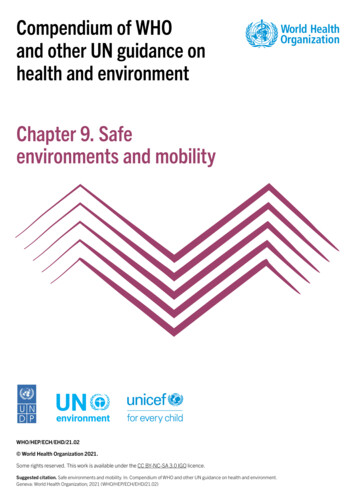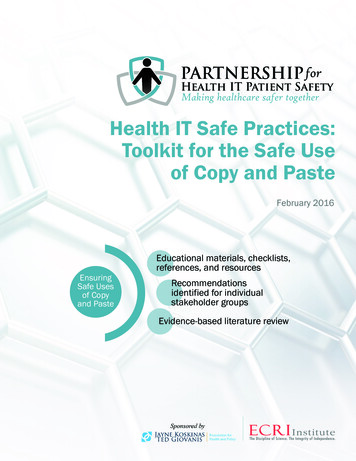
Transcription
Compendium of WHOand other UN guidance onhealth and environmentChapter 9. Safeenvironments and mobilityWHO/HEP/ECH/EHD/21.02 World Health Organization 2021.Some rights reserved. This work is available under the CC BY-NC-SA 3.0 IGO licence.Suggested citation. Safe environments and mobility. In: Compendium of WHO and other UN guidance on health and environment.Geneva: World Health Organization; 2021 (WHO/HEP/ECH/EHD/21.02)
9. Safe environments and mobilityContents9.1 Introduction .19.2 Environments for safe and sustainable transport, active mobilityand physical activity.29.3 Safe environments to prevent drownings, falls and burns.99.3.1 Drownings. 99.3.2 Falls.119.3.3 Burns. 149.1 IntroductionSustainable transport and mobility systems in this section refer to systems that are multi-modal whichsupport walking, cycling, other forms of active transport and mobility (e.g. such as skating, wheelchairs),as well as public transport in addition to private vehicles.Interventions towards sustainable transport and mobility systems are aimed at reducing road trafficfatalities and injuries while at the same time improving people’s health and well-being, protecting theenvironment and address climate change. They often have broad impacts, and would therefore berelevant for other sections of this compendium as well.1
Compendium of WHO and other UN guidance on health and environment9.2 Environments for safeand sustainable transport,active mobility andphysical activityOverviewSystems of mobility that include public transport and infrastructure for cycling and walking cancontribute to increasing levels of physical activity. The positive health effects of regular physicalactivity include improved muscular and cardiorespiratory fitness, improved bone and functionalhealth, reduced risk for NCDs such as cardiovascular diseases, cancer and diabetes, and fallsand fractures and weight control (1). Regular physical activity also improves mental and cognitivehealth and is recommended for people of all ages and abilities. Encouraging and enabling regularphysical activity requires adequate provision of, and equitable access to supportive environmentsthat encourage participation in walking, cycling, sports, active recreation and play by people of allabilities (2, 3).Transport can also affect health and health equity by enabling and facilitating access toeducation, decent jobs, health care, leisure and clean water. Road infrastructure and urbandesign can have an impact on social interaction within neighbourhoods while also discouragingmotorized transport and slowing the impact of climate change (4).Road traffic accidents kill 1.3 million people per year (2019 data); pedestrians, cyclists andmotorcyclists in low- and middle-income countries are disproportionally affected (5, 6). Morecycling and walking tends to lead to fewer road traffic accidents as motorists become sensitizedto the presence of non-motorized traffic and to sharing the road (7). Increased road safety andthe provision of public and green spaces can enable and motivate people to walk and cycle more,especially for short trips. Less motorized traffic also reduces air pollution, noise and carbonemissions.As the majority of the world population is living in urban areas, cities have a particularresponsibility and opportunity for improving urban design and transport systems to retain andsupport increasing levels of walking and cycling. Affordable and accessible transport systems andsustainable community infrastructure development are however equally relevant for peri-urbanand rural areas (4).2
9. Safe environments and mobilityHow do we assesssafe environments for,and levels of, physicalactivity in my country?For country assessment of population levels of physical activity in adults, theWHO STEPS approach includes the Global Physical Activity Questionnaire.This collects data on physical activity undertaken across three domains in thepast week: for transport (which is defined as walking and cycling; at work (paidand unpaid/around the home) and for recreation, leisure or sport. The GlobalPhysical Activity Questionnaire provides measures of the prevalence of walkingand cycling and time spent walking and cycling in the past week.Countries may have their own similar health surveillance system with questionson physical activity, however these do not always separate out a measure ofwalking and cycling from total physical activity or may not include walkingand cycling for transport. For example, some countries assess “sportsparticipation” only.For children there are school-based instruments that collect data on physicalactivity, and these can also include questions on travel to/from school bywalking and cycling. The global school-based student health survey andthe health behaviour in school-aged children survey are two widely usedinstruments and protocols.Personal transportation surveys, usually conducted by ministries of transportor similar agencies, can also collect data on walking and cycling trips. Thesequestions and data reporting vary between countries and there is no globalstandardized reporting available yet. Nonetheless, usually data are presentedas the proportion of trips by mode that can be tracked over time and assessedby setting (urban, rural) and by categories of trip length.Urban design for safe walking and cycling can be assessed using the roadsafety assessments and criteria set for roads achieving at least a 3 star rating(of a 5-star maximum) (8) for each road user (i.e. for pedestrians, cyclistsand users of public transit). New roads and urban infrastructure can beassessed during the development plan approval process. Both approaches arerecommended as part of the Decade of Action on Road Safety 2011–2020,the Global Action Plan on Physical Activity 2018–2030 and the WHO ACTIVEtechnical guidance toolkit to increase physical activity (2, 3).At the global level, countries can monitor their progress towards key SDGs towhich active mobility and physical activity contribute (9). These include thefollowing.SDG 3: Ensure healthy lives and promote well-being for all at all ages. Indicator 3.4.1: Mortality rate attributed to cardiovascular disease, cancer,diabetes or chronic respiratory disease. Indicator 3.6.1: Death rate due to road traffic injuries.SDG 11: Make cities and human settlements inclusive, safe, resilient andsustainable. Indicator 11.2.1: Proportion of population that has convenient access topublic transport, by sex, age and persons with disabilities. Indicator 11.7.1: Average share of the built-up area of cities that is openspace for public use for all, by sex, age and persons with disabilities.Other SDGs that are directly or indirectly transport-related include SDG 2 “Endhunger, achieve food security and improved nutrition and promote sustainableagriculture”, SDG 7 “Ensure access to affordable, reliable, sustainable andmodern energy for all”, SDG 9 “Build resilient infrastructure, promote inclusiveand sustainable industrialization and foster innovation”, SDG 12 “Ensuresustainable consumption and production patterns” and SDG 13 “Take urgentaction to combat climate change and its impacts”. In addition, SDG indicator3.9.1 monitors air pollution.3
Compendium of WHO and other UN guidance on health and environmentWhat do we want toachieve?Shift more passenger and freight travel to more environmentally friendlymodes (e.g. walking, cycling and clean public and freight transport) togetherwith improvements in the energy efficiency of all motorized transport modes(private and public) through low carbon fuel and vehicle technologies (10).Reduce passenger trips and freight movement by motorized transport modesthrough urban and regional development policies, integrated transport andspatial planning and travel demand management (11, 12).Investments in strengthening transport and mobility systems that take intoconsideration underlying social and environmental determinants of health canalso help to ensure equitable access to mobility and reduce disparities. Forinstance, improved mobility for women, children, older people and the pooralso enhances health equity (10), (11, 12), (7).People of all ages and abilities need to have equitable access to safe andappropriate places and spaces in their cities and communities in which theycan engage in regular physical activity. In addition, people need to know andunderstand the multiple benefits of regular physical activity which can beachieved through regular community-wide campaigns and education (2).WHO recommends that all children and adolescents achieve at least 60minutes of moderate to vigorous-intensity physical activity daily. Adults shoulddo at least 150 minutes of moderate-intensity physical activity or do at least75 minutes of vigorous-intensity physical activity throughout the week. Moredetailed recommendations on physical activity are provided in the Globalrecommendations on physical activity for health (13).Road traffic crashes and road injuries and fatalities can be reduced forexample through developing, implementing and enforcing a safe systemsapproach which places the focus on the design of the system rather than onroad user behaviour. Special attention needs to be paid to how systems thatare poorly designed put road users such as walkers and cyclists in positions ofvulnerability and the ways in which they can be amended (14).GuidanceSector principallyinvolved in planning/implementationLevel nalGovernanceGovernance: policies and actions1. Strengthen and support implementation of the HiAP approachat the national and subnational level (2, 15, 16) (See also section12.2 Health in All Policies).HealthOther sectorssuch as education,land use planning,finance, transport for allgovernance actions2. Build partnerships between the health sector and otherrelevant sectors such as transport and urban planning (2, 16).HealthTransportOther sectors4
9. Safe environments and mobilityGuidance3. Support the effective engagement and direct participation ofcommunities in planning and policy development (2, 16).Sector principallyinvolved in planning/implementationHealthOther sectors4. Conduct health, economic and environmental assessments offuture and existing policies and interventions (2, 16, 17).HealthEnvironmentLevel nanceUniversal healthcoverageNational;communityAssessment andsurveillanceUniversal healthcoverageFinanceOther sectorsRoad safety: policies and actions5. Develop or update national strategies, policies and actionsto improve road safety, especially safety of pedestrians andcyclists and other vulnerable groups such as children and olderpeople (2) communityAssessment andsurveillanceTransportHealthOther sectorssuch as education, landuse planning, finance,environment6. Establish a lead agency on road safety (14).TransportHealth7. Monitor road traffic deaths, injuries and crashes, risks such asalcohol or drug intake of drivers and protective factors such asaverage speed, helmet- and seat-belt-wearing rates and use ofchild restraint systems (14).8. Implement interventions for improving road safety withparticular focus on pedestrians and cyclists (2, 7, 18).Selected key interventions include the following. Provide sidewalks and dedicated cycle lanes to separatepedestrians and cyclists from motor traffic. Provide crossing enhancements for pedestrians and cyclists. Improve walking and cycling infrastructure aroundeducational facilities, public open and green spaces, sportsand leisure facilities and public transport hubs. Implement and enforce traffic speed limits and other trafficcalming interventions such as road-narrowing measures. Implement regulations to redistribute the impact of motorizedvehicles such as car-free zones, identify hazardous roadlocations and take corrective measures l healthcoverageNational;communityUniversal healthcoverageInfrastructure,technology andbuilt environment;other managementand controlThese engineering interventions need to be accompanied byeducation and enforcement of for example traffic laws and vehiclesafety standards.5
Compendium of WHO and other UN guidance on health and environmentGuidanceSector principallyinvolved in planning/implementationLevel logy andbuilt logy andbuilt logy andbuilt logy andbuilt environmentInfrastructure development, transport and mobility: policies and actions9. Develop or update policies that promote walking, cycling andnon-motorized transport policies and actions and set time-boundtargets (2, 3, 12).TransportLand use planning10. Prioritize active and sustainable mobility as preferredmode of travel in relevant transport, spatial and urban planningpolicies (2, 12).TransportLand use planning11. Ensure integrated transport and urban planning policies thatdeliver highly connected, mixed-use and compact neighbourhoodsthat promote and prioritize active mobility (2, 4, 10).This includes street design and urban development regulations thatpromote neighbourhoods that offer pedestrian and bicycle accessto shops, retail and services, green areas and educational facilities.12. Ensure provision of walking and cycling infrastructure on allstreets designed for use by pedestrians and cyclists according tobest practice street design standards and guidelines (2).Walking and cycling infrastructure should comply with thefollowing core principles (7). It should be safe and perceived as such under all weatherconditions, day and night. It should be accessible, forming an uninterrupted networkthat is linked with public transport services. It should be convenient, to allow direct and well-signalledaccess to homes, shops and workplaces as well as schools,recreation and leisure locations. It should be comfortable, to cater to all users, includingchildren and older people. It should be attractive, in terms of cleanliness, noise andquality of infrastructure offering pleasant surroundings andwell-functioning bicycle parking facilities.13. Redistribute space from private motorized transport tosupport active and more sustainable modes of transport (2).TransportLand use planningOther sectors suchas health environmentfinance labour educationTransportLand use planningTransportLand use planning14. Restrict car parking options for private vehicles to providemore public open and green spaces (2, 4).TransportLand use planning15. Implement proactive urban planning policies, building designand crime prevention strategies to increase access to and useof green infrastructure and safe public spaces, and to increaseactive and sustainable mobility (4, 12, 19).TransportLand use planningHousingConstruction6
9. Safe environments and mobilityGuidanceSector principallyinvolved in planning/implementationLevel ofimplementationInstruments16. Ensure access to good-quality public and green open spaces forpeople of all ages and abilities including safe play areas and sportsand recreational spaces for children and young people (2, 19).Land use y andbuilt environment17. Support people to be physically active through appropriatebuilding design and standards, particularly for all public buildingsand education and day-care facilities ology andbuilt environmentCommunityUniversal healthcoverageOthermanagement andcontrolNational;communityUniversal healthcoverageAssessment tion andcommunicationSelected proposed actions include: ensuring prioritized building access by pedestrians, cyclistsand public transport; providing clean, accessible and safe stairways; providing access to public open space; limiting car parking options; ensuring adequate provision of end-of-trip facilities, suchas secure bicycle parking, locker facilities and showers andchange rooms.18. Promote walking and cycling through free and accessiblepublic events that foster use of active mobility and green spacessuch as by regular closure of road networks to motorized vehiclesand walk/cycle to school/work programmes (2, 3).ConstructionHealthEnvironmentLand use planning19. Conduct economic assessments of walking and cyclinginfrastructure and all developments using HEAT (17).HealthEnvironmentFinanceOther sectorsAwareness raising and capacity building20. Conduct public campaigns to increase safe behaviours of roadusers, such as increased use of seat-belts and helmet wearing,and to reduce risky behaviours such as speeding, drink-drivingand the use of mobile devices (2, 7, 18).21. Raise awareness for the health benefits and the social,economic and environmental co-benefits of increased walking,cycling and other forms of active mobility (2, 17).HealthTransportHealthEnvironment22. Train professionals from different sectors such as health,education, transport and urban planning on the health, social,economic and environmental co-benefits of physical activity, andparticularly of more walking, cycling and other forms of activemobility (2).23. Conduct community surveys on perceptions of road safetyand walking and cycling to raise awareness of potential obstaclesand promote community discussion to determine solutions (3).HealthEnvironmentHealthEnvironmentUniversal healthcoverageCommunity;nationalUniversal healthcoverageCommunity;NationalUniversal healthcoverageCommunity;nationalUniversal healthcoverageInformation,education andcommunicationInformation,education andcommunicationInformation,education andcommunication7
Compendium of WHO and other UN guidance on health and environmentSelected toolsWHO 2021: Walking and cycling – a toolkit of policy recommendations (3)WHO Regional Office for Europe 2020: Moving around during the COVID-19 outbreak (20)WHO 2020: Urban health initiative: guidance and tools (16)UN-Habitat 2020: Integrating health in urban and territorial planning: sourcebook for urban leaders,health and planning professionals (12)WHO 2020: WHO manifesto for a healthy recovery from COVID-19 (21)WHO Regional Office for Europe 2019: Health Economic Assessment Tool (HEAT) for walking and cycling (17)The use of HEAT is recommended to support economic assessment of investment in walking and cyclingnetworks and new infrastructure.WHO 2018: Global action plan on physical activity 2018–2030: more active people for a healthier world (2)This plan recommends national policy actions and roles for various stakeholders in its Appendix 2.WHO 2018: ACTIVE: a technical package for increasing physical activity (22)WHO/Finland Ministry of Social Affairs and Health 2014: Health in all policies: Helsinki statement.Framework for country action (15)This document serves as a “starter’s kit” for applying HiAP in decision-making and implementationat national and subnational levels. It can be easily adapted for use in different country contexts and atregional and global levels.WHO 2013: Pedestrian safety: a road safety manual for decision-makers and practitioners (18)Dora et al. 2011: Urban transport and health. Sustainable transport: a sourcebook for policy makers indeveloping countries (4)WHO 2011: Health in the green economy. Health co-benefits of climate change mitigation – transportsector (10)8
9. Safe environments and mobility9.3 Safe environments toprevent drownings, fallsand burns9.3.1 DrowningsOverviewDrowning is a leading cause of unintentional injury and deaths worldwide and about 90% ofunintentional drowning deaths occur in low- and middle-income countries (6, 23). In 2019, anestimated 236 000 people died from drowning, making drowning a major public health problemworldwide (6). Children are at increased risk of drowning and 35% of drowning deaths occurred inchildren aged under 15 years.How prevalent aredrownings in mycountry?National reporting systems may capture statistics on drownings and otherinjuries.Injury surveillance guidelines are available to assess data on injuries (24).In addition, the WHO Global Health Estimates provide a comprehensive andcomparable assessment of death and disability due to diseases and injuries forall WHO Member States and all WHO regions of the world (25).GuidanceSector principallyinvolved in planning/implementationLevel ies and actions1. Develop or update water safety policies. Among these are safeboating, shipping and ferry regulations, which may include (26, 27): establishing systems that ensure vessel safety, availability offlotation devices in boats, avoidance of overcrowding, andappropriate travel routes and rules; laws on alcohol and drug use while boating or swimming; occupational safety measures, such as the wearing ofpersonal flotation devices and guard-rails, for example oncommercial fishing vessels.TransportOther sectorssuch as healtheducation migrationland use planningconstructionOther water safety policies may include signage and barriersfor high-risk locations, risk assessments for recreational watersettings (see section 3.2.2 Recreational water) and water safetylessons for schools.9
Compendium of WHO and other UN guidance on health and environmentGuidance2. Develop or update national water safety plans (WSPs) to buildresilience and manage flood risks and other hazards (26, 27).Level tionSchools/childcare settingsInfrastructure,technology andbuilt structure,technology andbuilt logy andbuilt environmentLand use y andbuilt environmentEducationSchools/childcare settingsOthermanagement ation andcommunicationSector principallyinvolved in 3. Provide safe places away from water for preschool children,including (the journey to) schools, child-care settings andrecreation and leisure settings (27).4. Support safe water systems, such as drainage systems andflood control (26).Environment5. Install barriers or fencing that control access to water, such aslids or mesh covers for open wells, playpens, doorway barriersand pool fencing in the form of four-sided, child-resistant fencesand self-closing gates with safety latches (27).HousingConstruction6. Create and maintain safe water zones for recreation (26).7. Establish supervised child-care programmes (26).Awareness-raising and capacity building8. Raise awareness of drowning to highlight the particular risksof children, as well as to signpost dangerous areas and preposition rescue equipment (26).Environment9. Implement individual and community education programmeson drowning risks and safety regulations (26).HealthEducation10. Implement training on basic swimming and water safety skillsfor school-age children (27).Universal healthcoverageInformation,education ation tion,education n11. Train the public in safe rescue and resuscitation (26).12. Raise awareness about the importance of emptying orcovering standing water and containers such as wells, tanks,cisterns and baths (26).Universal healthcoverageHealthUniversal healthcoverageCommunity;nationalUniversal healthcoverageInformation,education andcommunication
9. Safe environments and mobilitySelected toolsWHO 2017: Preventing drowning: an implementation guide (27) includes a situational assessment tool.WHO/CDC 2001: Injury surveillance guidelines (24)Guidelines to assess data on injuries that will help to develop effective prevention strategies in countries.9.3.2 FallsOverviewFalls are the second leading cause of accidental or unintentional injury or deaths worldwide. Eachyear an estimated 684 000 individuals die from falls globally, the majority of which occur in lowand middle-income countries (6) (2019 data). Environmental risk factors for falls include aspectsof the built environment such as poor building design, slippery floors and stairs and insufficientlighting (28).How prevalent are fallsin my country?National reporting systems may capture statistics on falls and other injuries.Injury surveillance guidelines are available to assess data on injuries (24).In addition, the WHO Global Health Estimates provide a comprehensive andcomparable assessment of death and disability due to diseases and injuries forall WHO Member States and all WHO regions of the world (25).While all people who fall are at risk of injury, the age, sex and health of theindividual can affect the type and severity of injury. Children and adults olderthan 65 years of age are among the high-risk groups, while the latter have thehighest risk of death or serious injury arising from a fall, with the risk increasingwith age (28).GuidanceSector principallyinvolved in planning/implementationLevel ies and actions1. Develop or update housing standards and buildingregulations (29).HousingConstructionHealth11
Compendium of WHO and other UN guidance on health and environmentGuidance2. Develop or update playground standards, such as for the depthof appropriate surface material, height of equipment and periodicmaintenance (30).Sector principallyinvolved in planning/implementationLevel nalRegulationNationalAssessment andsurveillance;infrastructure,technology andbuilt logy andbuilt environmentNational;communityAssessment andsurveillance;infrastructure,technology andbuilt environmentConstructionHealthEducation3. Promote policies requiring protective equipment such ashelmets during certain sports and leisure activities (30).HealthEducationSports and leisure4. Assess and improve safety, if needed, of sports andrecreational equipment (29).IndustryHealth5. Support the installation of window guards, bars and child-prooflocks for windows in high-rise blocks, stair guards or gates, grabrails, lockable access to balconies and hazard removal (29, 30).HousingConstruction6. Consider implementing home visits, assessment of homefurniture and environmental modification for people with childrenor those at an older age/with known risk factors or a history offalling, including stair gates and guard rails (28-30).HealthUniversal healthcoverage7. Promote physical activity to prevent falls (2).More guidance to promote physical activity especially thoughincreased levels of walking and cycling is listed in sectionHealthNational;CommunityUniversal healthcoverage9.2 Environments for safe and sustainable transport, active mobilityand physical activity.Awareness raising and capacity building8. Raise awareness about risks of falls, high-risk groups (childrenand older people) and available interventions (such as installationof window guards and grab rails, balcony risk and protection,promotion of physical activity, and hazard removal) (28, 29).HealthHousingCommunity;nationalUniversal healthcoverageInformation,education andcommunicationConstruction9. Give parents information about child fall risks and supportthem to reduce these risks around the home (30).HealthCommunity;nationalUniversal healthcoverage12Information,education andcommunication
9. Safe environments and mobilityGuidanceSector principallyinvolved in planning/implementation10. Provide parenting programmes for low-income and othermarginalized families (30).HealthLevel mation,education andcommunicationEducation ocial welfare andSfamily11. Provide school-based teaching of martial arts-based falltechniques and exercises ion andcommunication12. Make available gait, balance and functional training and TaiChi classes, the latter particularly to older people (30).HealthCommunity;nationalInformation,education andcommunicationSports and leisureUniversal healthcoverageSelected toolsWHO 2012: TEACH-VIP 2 users’ manual: the second iteration of Training, Educating and AdvancingCollaboration in Health on Violence and Injury Prevention (31)This is a comprehensive injury prevention and control curriculum that has been developed through theefforts of WHO and a network of global injury prevention experts.WHO/CDC 2001: Injury surveillance guidelines (24)Guidelines to assess data on injuries that will help to develop effective prevention strategies in countries.WHO 2018: Global action plan on physical activity 2018–2030: more active people for a healthier world (2)13
Compendium of WHO and other UN guidance on health and environment9.3.3 BurnsOverviewAn estimated 114 000 deaths every year are caused by burns (6) (2019 data), the vast majority ofwhich occur in low- and middle-income countries. Non-fatal burn injuries are a leading cause ofmorbidity, including prolonged
modern energy for all", SDG 9 "Build resilient infrastructure, promote inclusive and sustainable industrialization and foster innovation", SDG 12 "Ensure sustainable consumption and production patterns" and SDG 13 "Take urgent action to combat climate change and its impacts". In addition, SDG indicator 3.9.1 monitors air pollution.











